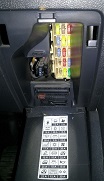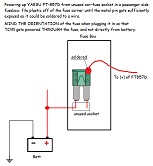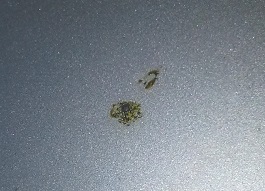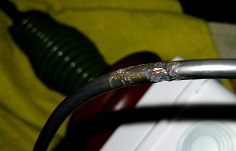This article describes an improvised field test of a newly acquired SG-230 automatic antenna tuner. After (lack of) proper planning and preparation (why wait?) test was carried out in... well, let's call it a bit less than ideal setup. This "a bit less than ideal" means: just a few most basic bits were hammered out in a rush and without giving it a second thought, new SG-230 along with FT-857D got shoved in a back-pack (tight fit), so I jumpped in a car and drove away. Destination: nearest possible (and untested) location which resembles nature, a drive-through park kind of away and a little bit above the urban radio-noise (or so I hopped). Sure enough, by the time junk box digging, soldering and crimping was done, it was late evening already.
What got hammered only provided power to FT857D and SG-230. While both are intended to be powered by 12V car battery (13.8V nominal), TCVR is declared peaking at 22 Amps and SG-230 at 0.9 Amps. This qualifies SG-230 to be plugged in to the cigarette lighter socket but FT-857D needs a bit more "serious" power source and it was found under the steering column, in a passenger side fuse-box (
picture below on the left) putting one of those unused sockets to good use.
SG-230 control cable only has 3 lines, two for power (+12V) and (GND) and the third one drives LED to indicate success finding a match. How else would a computer geek deal with it but by deploying CAT5e/CAT6 UTP LAN cable, hence an RJ45 socket sticking out of the lighter plug (
picture in the middle, above). Four out of eight UTP cable wires got dedicated to (GND) - one out of each pair, three to (+12V) power, and the last one drives the LED - green one on the picture as the red one does what it usually does, indicating power in the lighter socket itself (as if clacking of nearby SG-230 wasn't indication enough).
Rough idea for powering FT-857D is shown on the
picture above right. That provides a (+), and (-) was again taken out of the cigarette lighter socket, it's the black cable sticking out of the lighter plug other than UTP LAN cable. Everything is connected to the car body anyhow so couldn't be bothered any more with trivialities such as contact resistance and current load capacity.
Once at the destination and away from the asphalt, the system was set as shown on schematics below (click to view large picture):
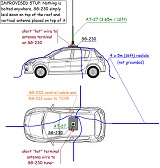
station layout
Hands-on impressions...
Not exactly surprising discovery: for reducing urban (radio) noise, a vertical antenna at ground level smack in the middle of the citty, even if be it in a bit elevated park, is not the best way to roll. No significant reduction of the noise floor noticed on the lower portion of HF (30m and longer). True, some usual residential chirps and whistles were missing but an overall noise level was almost spot on - all the way to 20m band. Upper bands (15m and up) as dead in the dead of the night as expected, exhibited noise floor at S1-S3, much better than from an apparment, but it is the noise nevertheless.
Nice surprise - 20m band was open until wee hours, and in spite of my not exactly favorable location in that direction, Dave
K0RK working from Tampa, FL with 100W and a Quad at 55ft above the gound was almost steady 57 with periodic QSB. With high noise at my end it's a margin of one S-unit only. His 53 to 57 report indicated less noisy conditions on his side and I don't know if his Quad had anything to do with it, hi, hi. Zeljko working
9A1TESLA on 40m phone less than 400 km (250 miles) away with 59+ sounded as sitting right next to me, and with 59 recevied my signal wasn't all that bad either. Almost the same situation with Victor
RC7KY over 1,000 km (670 miles) away. On 30m, Fabio
IK2WQH also working vertical reported 549 while his signals were 599 on my end. Back to 14.175, interrupting QSO party accross Portugal, Orlando
CS7ABM some 2,500 km (1,500 miles) away kindly reported 54-55 and explained I was getting in from the back of his quad. He, on the other hand, was loud 59 in the middle of the gloomy park in the dead of the night in Belgrade.
However, when attempting top band, tuner exhibited difficulties and was getting in endless tuning loops. Tuning with lower power at moments appeared to be doing the trick, but the first full power dit or daaa went out and we were back in the tunning loop. Needless to say, I could not have been bothered checking the SG-230 user manual beforehand ("if everything else fails, try reading the manual", right?), and if I did I would have found that at least twice the length of antenna was required to even remotely get me on 160m. True, no issues on 40m and shorter, but those endless tuning loops on 160m - not a nice thing to do. Giving up the tuning process, blinking the green LED or something would have been far more polite way of letting me know I'm out of line. Further more, after unsuccesful attempt at 160m, tuning on 80 meters became rather difficult as well, although that was not the case before 160m attempt. No tuning loops, but something was not right any more... as it turned out, it was not the poor SG 230 to blame.
After the fact...
The real reson behind those lower frequency "issues" became apparent tomorrow morning. Quick peak at the roof of the car told the story of epic battle SG 230 was trying to fight, leaving burn marks both on antenna lead connecting RF out of SG-230 to my vertical stick as well as on the roof itself. (Click an image below to enlarge)
Obviously the wire was in physical contact with the roof, see pictures above, and I can't exactly say much of an effort was given to prvent that from happening. Household wire insulation declared at 400 Volts AC just couldn't cope. On 160m this lump of vertical metal I so proudly proclaimed an antenna exhibits close to half an ohm in radiation resistance with reactance sky high so 100 W of CW must have pushed several kiloVolts through RF-OUT of SG-230 and in to the wire resting on the roof.
Note that SG-230 is
not a ballanced tuner, meaning DC ground and chases ground and common ground and all grounds are one and the same. Consequently, and even without intentional RF ground connection to car body, RG-213 shield connected to SG-230 and FT-857D ground were all connected to car body by the very fact these devices were powered up. Hence, the only thing between antenna lead carrying a couple of kV and the ground represented by the car roof was a little bit of metalic paint and the wire insulation. It had to melt and my car must have been glowing an alien-blue-ish, couldn't tell, I was inside of it. No wonder poor SG-230 was getting in to loops - as soon as the power increased, welding process kicked in and all parameteres went out and drifted with SG-230 trying (in vain) to remedy the situation and cope up with constant changes as the insulation was melting away. Also, no wonder 80m tuning was a bit difficult afterwards, with half the insulation already melted.
Moral of the story
- SG 230 in spite of impossible conditions behaved reasonably well
- Consider reading the manual... at least sometimes
- Tripple-check everything imagining it was not assembled by you but by someone you don't particularily like
- Always keep a fire extinguisher handy (for obvious reasons)
- If you spot faint blue-ish glow in the woods and hear a strange hissing noise, don't panic, it is not necessarily a UFO.
73!
de
YT5AAA
 english
english
 serbian
serbian
